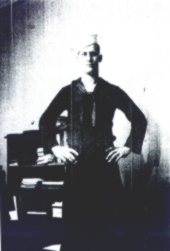Wess Ross - 146th Engineer Combat Battalion
Leader of 3rd Platoon, B-Company

The patch of the 146th
Engineer Combat Battalion.
Luckily for us, our P47s were rendezvousing near the Liege airfield for a strike of their own, and that caught these Germans by surprise as they were coming in. It must have been some dogfight, but we saw only the tail end of the action from our work area. In twenty minutes, as we watched in fascination, four ME 109s were shot out of the sky. The first one fell 1500 yards from us, and they kept dropping closer and closer until the last one was only 300 yards away.
The story was almost the same in every case. The 109 pilots, who were flying southeast and very close to the deck heading for home, were being slaughtered by the P47s. Our pilots were definitely more aggressive, and must have had superior training and experience. We didn't see any parts being shot off the 109s, but two were spewing smoke before they crashed and sent up big black pillars. The third downed plane hit 600 yards away, and several of us headed out to see what we could find of interest, (read Lugers of P38s) We had just started off, when another 109 came limping toward us, smoking and losing speed and altitude.
The P-47 kept boring in and firing short machine gun bursts. The 109 was hidden by a group of pine trees when the pilot finally hauled back on the stick in an attempt to gain enough altitude to jump. His plane rose only a few hundred feet, coming back into our field of view, and then stalled just as he bailed out. We charged down the hill to the crash site, fully expecting to find a dead pilot near the wreckage, since we were sure that he had lacked sufficient altitude to safely eject.

Wess Ross, GI in a borrowed sailors uniform during wwii.
After escaping death in such a remarkable exit by parachute, we were saddened the next morning to find the young pilot death within our minefield. He had crawled inside the wire barrier and suffered modest wounds from an antipersonnel mine. We surmised that he believed he would freeze to death before the morning, so he killed himself with his 9mm P-38. (Mentioned in the battalion's S-1 record of 03 January 1945)
Death of the German Luftwaffe
This attack from the Luftwaffe on January 1, 1945 was operation Bodenplatte. The plans for this operation where made during a meeting in the headquarters of Jagdkorps 2 near Altkirchen on December 15. Major-General Dietrich Pelz planned an attack on sixteen Allied airfields in Belgium, Holland and Northern France. Reconnaissance missions where send to all the fields in advance of the attack. Due to the bad weather it was only on December 31st that the German Squadron commanders received the word that the operation would take place.It is not exactly clear how many German fighters took part in the operation, the numbers in the literature vary from 660 to 1100. Fact is that every airworthy fighter in the area took part in the operation. The fighters maintained radio silence on their way to their targets and flew almost on treetop level in an attempt to avoid being recognized by Allied radar.
The German attack did come as a complete surprise to the Allies and they did manage to destroy around 300 Allied aircrafts. But it turned out that it was a victory that the German Luftwaffe could not afford. The Luftwaffe lost nearly 300 aircrafts, several of them by fire from their own troops. A great number of pilots where captured or killed, among which more than fifty experienced flyers, such as aces and flight instructors.
© All rights reserved
Contact






